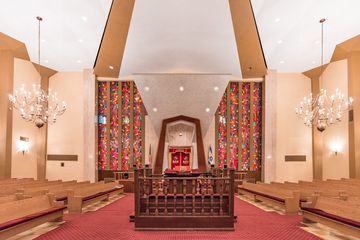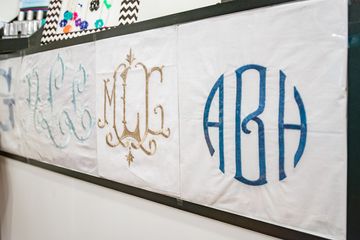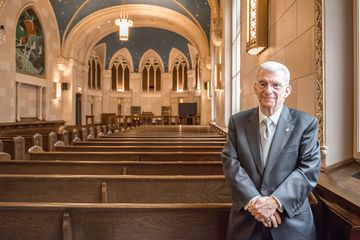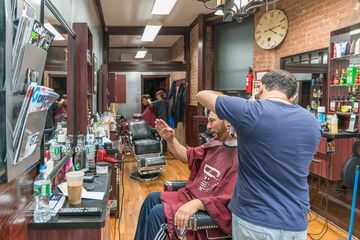If there were a lifetime achievement award for funeral directors, Charles Salomon would be an obvious candidate. He has worked in the business for over fifty years and, in his words, has had a very full career. He has been honored with positions on several important boards: he has been president of the Jewish Funeral Directors, is on the board of the Metropolitan Funeral Directors Association, is the official funeral director of Temple Emanu-el, and is a prominent member of many synagogues. Recently, the National Funeral Directors Association magazine featured Charles on its cover. Quoting Billy Crystal, Charles said, “If you hang around the store long enough, they give you something. ”He gave me a thorough explanation of the history not only of Riverside Memorial Chapel, but also of Jewish funerals in general. Charles took me back to the very beginning, during the bulk of Jewish migration to New York in the mid-1800s. The Jewish population mainly settled on the Lower East Side and needed a place to bury their dead. According to traditional practices, when a Jewish person died, men or women volunteered to wash the body and dress it in a hand-sewn linen shroud – Charles shared that his great-grandmother sewed these shrouds for her congregation (now the linens are bought from the Orthodox women who continue to hand-stitch them). There were no funeral homes, just the houses of the deceased’s loved ones. The body was then placed in a pine box and sent to the cemetery. During this whole process, the only person who needed to be specifically hired, Charles pointed out, was the coach-driver who drove the coffin to Queens, where many of the cemeteries were located. It was, therefore, the livery owners who eventually became the funeral directors, seeing an opportunity to give further to their community. Eventually, coaches turned into hearses and carriages morphed into limousines. Charles then branched off from this general history to tell the more specific story of Riverside Memorial Chapel. Louis Meyers, he explained, was a stableman who wanted to start his own business. Together with his eldest daughter, Sarah, he began a livery business in 1897 on Norfolk Street that helped transport the dead in a neighborhood that suffered from overpopulation and disease. A salesman named Charlie Rosenthal married Sarah and helped run the business. In the early twentieth century, the Jewish population began migrating to East Harlem and the Meyers family went with them. It was not long, however, before the Roaring Twenties, when some Jewish families were able to afford a move to the Upper West Side. Charlie Rosenthal and his children followed the pack and built Riverside Memorial Chapel in 1926. Charles pointed out that there was not a public funeral facility before Riverside Memorial, making it the first of its kind. Many aspects of the funeral home changed over the years. For example, Jewish people attending non-Jewish friends’ funerals began to request more ornate caskets, though still made without metal. Also, as the new population aged, the funeral home became overcrowded, causing an expansion into the building next door in 1949. In the early sixties, Charles’s own story joined that of Riverside Memorial Chapel’s. His family was very close with the Rosenthals, and Morty Rosenthal (one of Charlie Rosenthal’s sons) asked Charles’s father, “What’s Charles going to do after college? ” Despite the fact that Charles had plans to go to law school, Morty asked if he wanted a job at Riverside. Charles turned to his father and cried, “Dead bodies, Dad? That’s what you want for me? ” He ended up eating his words after he graduated from law school and found there were no jobs to be had. His father took him to Barney’s to get a black suit and Charles promised himself that he would try working in the funeral home for six months. On his first day, however, he was asked to hop in one of the shiny black cars and drive it out to Queens. As a young man in a nice car with important jobs to do, Charles said he was a “Kid in a candy store, ” adding, “From day one I was mesmerized. ”In the meantime, the Rosenthal's were amassing an empire. After having split from Meyers in 1933, the Rosenthals built a national funeral car company that could be hired out by different funeral homes. They partnered with Caesar Kimmel's Kinney Parking Company and began providing cars and drivers throughout the country, along with garages and ordinary rental cars. However, after Jessica Midfit’s exposé on certain funeral home practices, American Way of Death, was published, the Rosenthal's started divesting from the funeral side of the business. New legislation in response to her piece made it more difficult to be a funeral director. It was at this point that Morty Rosenthal took Charles to breakfast to tell him that he was in negotiations, but specifically mentioned that Charles was part of the deal and that he was guaranteed a job. “They were good people, ” Charles stated simply. What did the Rosenthal's do next? They took the next logical step in building a conglomerate; they bought Warner Brothers. Because of this, television shows and film production companies often use the Chapel for shoots. “But when they leave, they leave it spotless, ” Charles assured me. Charles was sure to mention that though the establishment focuses primarily on the Jewish funeral experience, the Chapel welcomes all faiths. Talmudic law (and, to an extent, U. S. law), he informed me, specifically requires the Chapel to “provide assistance to anyone who knocks on their door. ” These days, funerals are often live-streamed, so family members can witness the funeral rites of a loved one “all the way from Israel. ”I sat mesmerized by Charles Salomon for over an hour and a half. How often does one get to learn the history of something as important as a funeral from a true expert. I do not believe that there is anyone today who knows it better than this fine gentleman. Although I was young, I do have memories of not one, but three different funerals held at Riverside for my two grandfathers and my grandmother. I can still remember standing outside, confused, sad, but, at the same time, fascinated at how well this West 76th Street machine was oiled.





